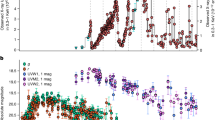Abstract
NITROGEN which has passed through a discharge contains free atoms: their recombination gives rise to the long-lived, yellow, Lewis–Rayleigh afterglow (LRA)1 which is composed mainly of first positive bands (B3Πg→A3Σ+u) with v′ ≤ 12 (the dissociation limit). Microwave discharges in pure nitrogen also give a short-lived, pink afterglow (PA)2,3. In this case, the first positive bands are excited to much higher vibrational levels and there is strong emission of the first negative bands (N+2, B2Σ+u→X2Σ+g). A remarkable feature is the dark space separating the discharge and the PA in which only the weaker LRA is visible. The only additional energy carrier that has been detected4,5 is vibrationally excited, ground state nitrogen—N2†; from Bass's data, one can estimate Tvib∼104 K. It is not known whether vibration–vibration exchange will lead to a Boltzmann energy distribution in the PA (∼10 ms after the discharge), so the term Tvib is used loosely, but it is certain that vibrational energy will not equilibrate rapidly with translation and rotation (the “gas kinetic” temperature will here be called Tkin). On the other hand, equilibration between vibrational energy of N2 and kinetic energy of the electrons (reaction (2)) is very fast6 and average electron energies of ∼4 eV have been found in the PA7.
This is a preview of subscription content, access via your institution
Access options
Subscribe to this journal
Receive 51 print issues and online access
$199.00 per year
only $3.90 per issue
Buy this article
- Purchase on Springer Link
- Instant access to full article PDF
Prices may be subject to local taxes which are calculated during checkout
Similar content being viewed by others
References
Brocklehurst, B., and Jennings, K. R., Prog. React. Kin., 4, 1 (1967).
Beale, G. E., and Broida, H. P., J. Chem. Phys., 31, 1030 (1959).
Oldenberg, O., Bull. Amer. Phys. Soc., 12, 217 (1967); A Theory of the Auroral Afterglow of Nitrogen, AFCRL-67-0252 (1967).
Bass, A. M., J. Chem. Phys., 40, 695 (1964).
Tanaka, Y., Innes, F. R., Jursa, A. S., and Nakamura, M., J. Chem. Phys., 42, 1183 (1965).
Hurle, I. R., J. Chem. Phys., 41, 3592 (1964).
Chen, S.-L., and Goodings, J. M., quoted in ref. 8.
Anketell, J., and Dugan, C. H., J. Chem. Phys., 50, 1893 (1969).
Lund, R. E., and Oskam, H. J., Z. Phys., 219, 131 (1969); Brömer, H. H., and Hesse, J., ibid., 219, 269 (1969).
Brömer, H. H., and Döbler, F., Z. Phys., 185, 278 (1965).
Dugan, C. H., J. Chem. Phys., 47, 1512 (1967).
Brocklehurst, B., and Duckworth, R. M., J. Phys., B, 1, 990 (1968).
Jeunehomme, M., and Duncan, A. B. F., J. Chem. Phys., 41, 1692 (1964).
Jeunehomme, M., J. Chem. Phys., 45, 1805 (1966).
Campbell, I. M., and Thrush, B. A., Trans. Faraday Soc., 65, 32 (1969).
Author information
Authors and Affiliations
Rights and permissions
About this article
Cite this article
BROCKLEHURST, B., NICHOLLS, R. Pink Afterglow of Nitrogen. Nature 223, 824–825 (1969). https://doi.org/10.1038/223824a0
Received:
Issue Date:
DOI: https://doi.org/10.1038/223824a0
This article is cited by
-
Role of Vibrational Relaxation in the Pink Afterglow of Nitrogen
Nature Physical Science (1972)
Comments
By submitting a comment you agree to abide by our Terms and Community Guidelines. If you find something abusive or that does not comply with our terms or guidelines please flag it as inappropriate.



